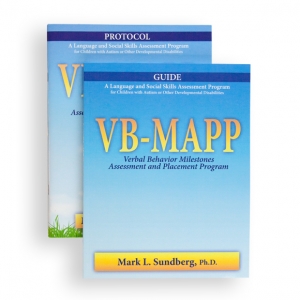 Available at AVB Press and Dr. Mark Sundberg’s website.
Available at AVB Press and Dr. Mark Sundberg’s website.
The VB-MAPP is a criterion-referenced assessment tool, curriculum guide, and skill tracking system that is designed for children with autism, and other individuals who demonstrate language delays. The VB-MAPP is based on B.F. Skinner’s (1957) analysis of verbal behavior, established developmental milestones, and research from the field of behavior analysis. There are five components of the VB-MAPP, and collectively they provide a baseline level of performance, a direction for intervention, a system for tracking skill acquisition, a tool for outcome measures and other language research projects, and a framework for curriculum planning. Each of the skills in the VB-MAPP is not only measurable and developmentally balanced, but they are balanced across the verbal operants and other related skills. For example, many aspects of an intraverbal repertoire are based on an existing tact and listener repertoire. The VB-MAPP balances the curriculum in an attempt to avoid the common trap of developing rote responding due to deficiencies in the related verbal repertoires.
VB-MAPP Skills Assessment
The first component is the VB-MAPP Skills Assessment. This part of the assessment is designed to provide a representative sample of a child’s existing verbal and related skills. The assessment contains 170 milestones balanced across the verbal operants and 3 developmental levels (0-18 months, 18-30 months, and 30-48 months). The skills assessed include the mand, tact, echoic, intraverbal, listener, motor imitation, independent play, social and social play, visual perceptual and matching-to-sample, linguistic structure, group and classroom skills, and early academics. Included in the VB-MAPP Skills Assessment is a subtest developed by Dr. Barbara Esch CCC-SLP. Dr. Esch’s Early Echoic Skills Assessment (EESA) provides a detailed assessment of early echoic behavior. Dr. Esch’s many suggestions as both a Speech and Language Pathologist and a Behavior Analyst trained under Dr. Jack Michael have been invaluable to the development of the VB-MAPP.
VB-MAPP Barriers Assessment
The second component is the VB-MAPP Barriers Assessment, which provides an assessment of 22 common language and learning barriers faced by children with autism and developmental delays. The barriers include instructional control, behavior problems, defective mands, defective tacts, defective imitation, defective echoic, defective matching-to-sample, defective listener skills, defective intraverbal, prompt dependency, defective generalization, scrolling, defective scanning, defective conditional discriminations, weak motivators, response requirement weakens the motivators, self-stimulation, defective articulation, obsessive compulsive behavior, reinforcer dependency, defective attending, and defective social skills. By identifying these barriers, the clinician can develop more effective intervention strategies and allow for more effective learning. The Skills Assessment along with the Barriers Assessment provides a solid overall view of a child.
VB-MAPP Task Analysis and Skills Tracking System
The third component is the VB-MAPP Task Analysis and Skills Tracking System, which provides a further breakdown of the skills (the steps supporting the milestones), and serves as a more complete and ongoing language and learning skills curriculum guide. There are over 1000 skills presented covering the 16 areas of the VB-MAPP. This VB skills task analysis presents a new sequence of the verbal behavior curriculum that is developmentally balanced and represents over 30 years of field-testing and revisions.
VB-MAPP Transition Assessment
The fourth component is the VB-MAPP Transition Assessment, which contains 18 assessment areas and can help to identify if a child has acquired the skills necessary for learning in a less restrictive educational environment. The assessment is comprised of several summary measures from other parts of the VB-MAPP, as well as a variety of other skills that can affect transition. The assessment includes measures of the overall score on the VB-MAPP Skills Assessment, negative behaviors, group skills, social skills, independence, classroom routines, play skills, toileting, eating, spontaneity, reinforcer effectiveness, natural environment learning, generalization, rate of acquisition, retention, transfer skills, self-care, and safety.
VB-MAPP Placement Guide and IEP Goals
The fifth and final component is the VB-MAPP Placement Guide and IEP Goals, which correspond with the assessments above. The placement guide provides specific direction for each of the 170 milestones in the Skills Assessment as well as specific suggestions for IEP goals. The placement recommendations can help the program designer balance out an intervention program, and ensure that all the relevant parts of the necessary intervention are included.
The overall results of the VB-MAPP will provide valuable information that will serve as a guide for the development of an effective individualized language, social skills and learning curriculum.
